 |

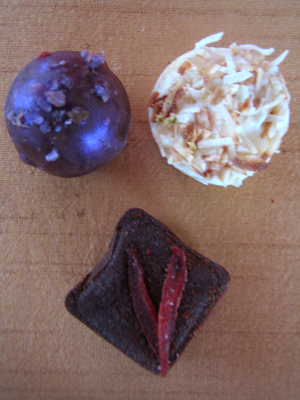 |
| We could frame it—but we’d rather eat it. From the top left, Wen’s signature confection, the Violette truffle infused with black violet tea; Triglav, a white chocolate infused with aromatic lime, topped with toasted coconut; and Savannah, infused with honey pepper vodka and hot paprika and topped with chile mango. All photography by Melody Lan. |
| WHAT IT IS: The finest-quality gourmet truffles (ganache-filled chocolates). |
| WHY IT’S DIFFERENT: Both classic and innovative flavors and the ability to buy only the pieces you want. And so reasonably priced! |
| WHY WE LOVE IT: Among the great chocolates in America. Should we admit we ate the whole box within 15 minutes? Each piece was so good, we couldn’t wait to try the next. |
| PURCHASE AT: WenChocolates.com. |
|
|
 |

Wen is Now!
Wen Chocolates
CAPSULE REPORT: Every time we think we have settled down with a “favorite chocolatier,” we discover a new favorite. Chef Will Poole of Wen Chocolates makes chocolates just as we like them: exciting concepts, perfectly articulated flavors and, as you can see in the photo, exquisitely crafted pieces. While the most demanding connoisseur would covet a box, anyone who loves fine chocolate will treasure one.
Poole understands that chocolate-lovers have their preferences. He sells his chocolates online by the piece, ensuring that every piece you get is a flavor you want—no Forrest Gump dilemma. (If you don’t like to make choices, there are pre-set assortments.) At $1.50 per piece, these chocolates are beautifully priced as well as beautiful to taste—and before you do that, beautiful enough to simply admire as art. Read the full review below. (If your email client does not support anchor links, scroll down.)
|
Chocolate-Lover’s Reading List
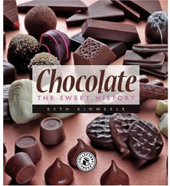 |
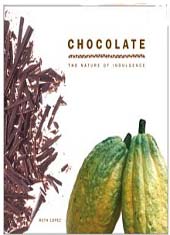 |
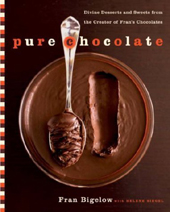 |
| Chocolate: The Sweet History, by Beth Kimmerle. Richly illustrated, this book celebrates America’s favorite sweet indulgence with a comprehensive history of our favorite candy. Click here for more information. |
Chocolate: The Nature of Indulgence, by Ruth Lopez. Dive into the world of chocolate. Learn everything about chocolate from its history and ecology, anthropology and economics, to its conservation and popular culture. Click here for more information. |
Pure Chocolate, by Fran Bigelow. One of America’s favorite chocolatiers shows you how to become an amateur chocolate chef, from glorious tarts to refreshing sorbets. A guide to tempering chocolate is also included. Click here for more information. |
Wen is Now: Wen Chocolates
We sit in an office surrounded by a 100 pounds of the best specialty foods in the world. At least 20 pounds of them must be chocolate. We need only reach out to the box of samples at our feet—literally—to enjoy some of the biggest-name prestige brands. Some of them have been sitting here for months, even though we brought them back from travels specifically to taste for THE NIBBLE. Yet, as eager as we were to purchase them, now that they are here, we have not even opened the boxes. Why? Sometimes, life at THE NIBBLE™ is too much of a good thing, and no matter how excellent we know products are, it takes the promise of something different and exciting to turn our head.
That event happened on our birthday a couple of months ago, when one of our editors, also a chocolate 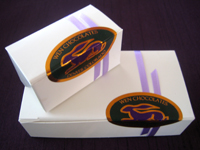 writer, rose to the head-turning challenge. She sent us Wen Chocolates, new to our acquaintance. For such great chocolate, it arrived in unprepossessing boxes. But the first thing we learned as a young consumer—and in fact, the reason we began writing THE NIBBLE™ newsletter several years ago—is that packaging has nothing to do with the quality of what’s inside. Personally, when we buy chocolate for ourselves or as gifts for fellow food-lovers, we’re not buying pretty boxes and bows. writer, rose to the head-turning challenge. She sent us Wen Chocolates, new to our acquaintance. For such great chocolate, it arrived in unprepossessing boxes. But the first thing we learned as a young consumer—and in fact, the reason we began writing THE NIBBLE™ newsletter several years ago—is that packaging has nothing to do with the quality of what’s inside. Personally, when we buy chocolate for ourselves or as gifts for fellow food-lovers, we’re not buying pretty boxes and bows.
With Wen, you buy a bit of philosophy to begin with. Wen is ancient Egyptian for “to exist,” which was symbolized by the rabbit, the company logo. Wen was chosen by the chocolatier to represent a melding of the historic and the modern. Perhaps Wen presents the pioneering creativity of the Egyptians of antiquity, but the artistic panache is 21st-century, and the tantalizing flavors belong to demanding palates of every age. Let us assure you that enjoying the chocolates as you contemplate your existence and that of mankind in general—and that mankind evolved the talent to make such fine chocolates and your palate evolved to appreciate them—is philosophically enriching.
|
Each handmade confection is crafted with the finest, all-natural ingredients. The couverture is mostly E. Guittard, the premium line from Guittard Chocolate Company, one of America’s finest chocolate producers. More specifically, Chef Poole prefers the 61% cacao Lever du Soleil couverture, a blend of South American cacaos, for his dark chocolates (both for the enrobing chocolate and the ganache). The milk chocolate is the Orinoco 41% cacao from Venezuelan beans (caramel tones with a hint of cinnamon).
For three of the pieces, Chef Poole uses a mix of E. Guittard and Plantations, a couverture made exclusively from the Arriba bean,* in 75% and 100% cacao. The Kochac truffle is made completely from Plantations couverture. The Violette and Mocja truffles are made with a mix of the two couvertures.
*Plantations is a producer that specializes exclusively in Arriba cacao, also called Nacional. The Arriba bean is naturally sweeter than other cacao beans: you can eat a higher-percentage cacao bar that will have less bitterness compared to other brands (the higher the percentage of cacao, the less sugar in the chocolate). We have eaten their 100% cacao bar—it has absolutely no sugar—and love it. |
|
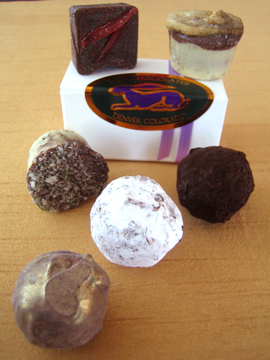
From top left, clockwise: Savannah, Bananas Foster,
Pain d’Epices, White Cloud, Prazen Sladkor and Mint Julep.
|
Truffle Flavors
Most of the names of the individual truffles—Southern, French, and Eastern European in origin—reflect the different places where Chef Poole has worked.
- Bananas Foster Truffle. A rich melding of William’s Wicked Caramel and milk chocolate ganache with toasted Saigon cinnamon, topped off with a banana chip.
- Bourbon-Vanille Truffle. Dark chocolate ganache infused with smoky bourbon and hints of vanilla, dipped in dark chocolate and rolled in lightly-salted peanut dust.
- Cairo Truffle. Named after a rose tea, milk chocolate ganache delicately infused with Keemun tea from China and pink rose petals from India.
- Kochac Truffle. The classic French chocolate truffle: pure dark chocolate rolled in Dutch-process cocoa. Kochac is the Polish word for love, but you don’t have to be Polish to love this truffle.
- Milan Truffle. Aromatic milk chocolate coffee ganache with a pinch of nutmeg, garnished in white chocolate. Named after the chocolatier’s nephew, who wanted a coffee truffle (thanks, nephew).
- Mint Julep Truffle. Milk chocolate ganache infused with bourbon and mint, then topped with candied mint leaves.
- Mocja Truffle. Dark chocolate ganache infused with smoky, mild Aleppo chile, then dipped in more dark chocolate. Named after a colleague who had a fiery personality.
- Pain d’Epices Truffle. The French word for gingerbread, a milk chocolate truffle flavored with molasses, black pepper and other aromatics and rolled in Dutch-process cocoa.
- Prazen Sladkor Truffle. William’s Wicked Caramel in a dark chocolate cup, dipped in dark chocolate and dusted with edible gold mica luster. The name is a Slovenian term for lost or burnt sugar (Chef Poole taught in Slovenia).
- Savannah Truffle. A rich blend of dark chocolate infused with Ukrainian honey pepper vodka, topped with a chile mango and hot Hungarian paprika. The blend of flavors reminds Chef Poole of the Georgia town.
- Triglav Truffle. White chocolate infused with lime, spiced rum, and white pepper; then coated with white chocolate and rolled in toasted coconut and lime zest. This “white peaked” truffle is named after a mountain range in Slovenia.
- Troika Truffle. Dark chocolate infused with Ceylon, Chinese and Indian black teas and then delicately combined with grapefruit, orange and tangerine essences. Each truffle is then dipped in more dark chocolate and lightly dusted with edible gold luster. Troika is the Russian word for “three,” as in three teas, three citrus flavors.
- Violette Truffle. Wen’s signature confection, dark chocolate ganache infused with black violet tea, dipped in more dark chocolate and topped with candied violets and aubergine mica luster. Named after the heroine of the opera, “La Traviata.”
- White Cloud Truffle. Another classic French truffle, dark chocolate infused with cognac, then dipped in more dark chocolate and rolled in confectioners sugar.
Might we say that Wen is currently among our top three favorite chocolate collections? Based on Chef Poole’s gifts as a chocolatier, we also look forward to the ginger snaps, toffee and other goodies in his online store. If you are in Denver, stop by in person: several fine stores sell the chocolates, and the Wen Chocolates store at 1801 Wynkoop Street is open weekdays from 10 a.m. to 6 p.m. (1.720.891.4622).
Our Favorites
We all like something different, of course. You might want to eat an entire box of those impeccable classic chocolate truffles, Kochac and White Cloud. We personally could do the same with the spicy truffles, Mocja and Savannah. And while heat and chocolate may not be everybody’s cup of tea, there are three tea and chocolate truffles, Cairo, Troika and Violette.
Because people ask, here’s what we’d put in our box if we had to choose by the piece:
- Classics. Prazen Sladkor—bite into the round chocolate shell and a heavenly liquid caramel drips into your mouth. “Standard” flavors like Bourbon-Vanille, Mint Julep and Milan (coffee ganache) are anything but standard.
- New Classics. Bananas Foster, Violette and Troika (black tea and citrus).
- Spicy. Savannah (hot paprika) and Mocja (mild Aleppo chile), homages to the way chocolate started more than 3,200 years ago, as a spicy Olmec and Maya beverage (the Mayas later traded chocolate to the Aztecs).
Would we eat all the others again? Absolutely—and very soon!
What Is Couverture
Couverture (meaning coating) chocolate is professional-quality chocolate made with better beans, ground to a finer particle size and with a higher cocoa butter content than most chocolate bars for eating†. It is used to enrobe candies and other confections (chocolate-covered pretzels, e.g.). Couverture comes in kilo (2.2 pound) to 10 pound bars or blocks. Some companies make smaller bars and “wafers,” discs smaller than a quarter, for the home baker and chocolatier.
†Fine chocolatiers, of course, make their chocolate bars from the same quality couverture.
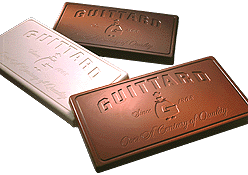 Couverture is tempered to form a thin, smooth, shiny coating on hand-dipped candies. The extra cocoa butter, generally 36% to 39%, makes it easier to work with, allows for a thinner shell coating and gives it a different texture and consistency than non-couverture chocolate, i.e. chocolate bars. (Bars for eating can be 25% to 33% cocoa butter, depending on the quality of the bar.) Couverture is tempered to form a thin, smooth, shiny coating on hand-dipped candies. The extra cocoa butter, generally 36% to 39%, makes it easier to work with, allows for a thinner shell coating and gives it a different texture and consistency than non-couverture chocolate, i.e. chocolate bars. (Bars for eating can be 25% to 33% cocoa butter, depending on the quality of the bar.)
Each chocolatier decides which brand of couverture to use, depending on his or her personal tastes. Some use more than one brand and/or different blends of beans, origin couvertures or percentages of cacao within a brand, based on their feeling that specific couvertures pair better with particular items. For example, even within semisweet chocolate, one couverture might taste better with nuts; another with fruits, fruit cremes and peel; another with caramels and toffee; and yet another with plain bars and ganaches.
- Brands popular among U.S. chocolatiers include Callebaut, El Rey, Guittard and Valrhona. Callebaut’s chocolate is certified kosher, so chocolatiers who want to make the finest kosher chocolate generally use it.
- Some chocolatiers use the manufacturer’s straight product, others might blend different blocks to get their desired result. Still others might have the chocolate manufacturer blend a special “recipe” according to the chocolatier’s own specifications (e.g., more cocoa butter for a smoother mouthfeel, more Venezuelan beans in the mix for a fruitier chocolate).
To understand your flavor preferences, ask chocolatiers which couverture they use: it gives the chocolates their defining taste, regardless of fillings. By understanding, e.g., that you like Couverture A but don’t like Couverture B as much, you will understand your preferred flavor profile. (It’s like knowing that you like the fruitier style of many California Pinot Noirs better than the more balanced style of many Oregon Pinot Noirs.) Most chocolatiers don’t make a secret of the brand of couverture they use—they’re proud of their choice(s) and want you to be an educated consumer. And, knowing your preferences lets you make more informed choices the next time you purchase chocolate. If you know you enjoy chocolate made with Guittard couverture, e.g., the next time you see a Guittard chocolate bar, you might stop to buy it. Or, the next time you encounter a new chocolatier and find that he or she uses Guittard couverture, you know you have a good chance of really enjoying those chocolates.
NOTE: Even if you don’t like a particular couverture in chocolates, it will probably taste splendid in baked goods and ice cream, where the flavor is nowhere as intense as biting into a chunk of it. One brand that has flavor notes that we don’t enjoy in eating chocolate is one of our top choices for baking and for making ice cream.
For an overview of some of the great chocolate producers in the world, read our article, “House Tour: The World’s Great Chocolate Houses.”
Truffle
The word truffle has several meanings in the world of candy—like praline, you have to clarify what is being discussed. That’s because in different countries, words mean different things, and America, the great melting pot, has polyglot references to many things.
- A French invention, the original chocolate truffle was a ball of ganache, often flavored and rolled in cocoa. It was named after the precious black truffle fungus because of its physical resemblance. Sometimes the ganache is rolled in white confectioners sugar or finely chopped nuts; modern truffles can be coated in peppercorns, sweet curry and paprika and can be enrobed in couverture.
- In 1912, the Belgian chocolatier Jean Neuhaus invented the first hard chocolate shell (also called couverture), enabling fillings of any kind and consistency—creme, whipped cream, soft caramel, light ganache, liqueurs et al. Previously, only solid centers like caramels and nut pastes could be enrobed in chocolate—anything else would have leaked out.
Now come the layers of confusion:
- The hard chocolate shell that gets filled is called couverture; so are the large blocks of chocolate that get melted down to make it.
- Jean Neuhaus called these new filled chocolates pralines, the same word used to describe the caramelized almonds that had been made by the French (and known to the Belgians) since 1636. The French call filled chocolates chocolats fourrés; they call chocolates in general bonbons de chocolat or chocolats assortis.
- Back to chocolate truffles (i.e., balls of ganache): the word truffle is often used in America to describe any filled chocolate. If it is applied to a filled, hard-shell chocolate, the term should be limited to shells filled with ganache. In the case of Wen Chocolates, the term is appropriate because almost all of the chocolates are filled with ganache.
Alas, there is nothing we at THE NIBBLE can do to enforce a common chocolate language: we can only explain the Tower of Culinary Babel. |
Where should you begin? Well, Mother’s Day is coming, and Father’s Day...but there’s no need to wait for a Hallmark holiday to enjoy great chocolate. The best reason to order a box of Wen right now is the same reason that we, who are surrounded by 20 pounds of fine chocolate, are going to: because it’s exciting, a great value and we deserve it.
—Karen Hochman
FORWARD THIS NIBBLE to anyone who loves great chocolate, needs to give an impressive gift, or is planning ahead for Mother’s Day and Father’s Day.
WEN CHOCOLATES
Assorted Truffles
- Individual Truffles
Single Truffle: $1.50
Two-Piece Box: $3.00
Four-Piece Box: $5.99
Six-Piece Box: $8.99
Twelve-Piece Box: $17.99
- Pre-Set Assortments
Milk or Dark Chocolate
6 Pieces $8.99
12 Pieces $17.99
Purchase online at WenChocolates.com.
Or telephone 1.720.891.4622, Monday
through Friday from 10 a.m. to 6 p.m.
Mountain Time. |
 |
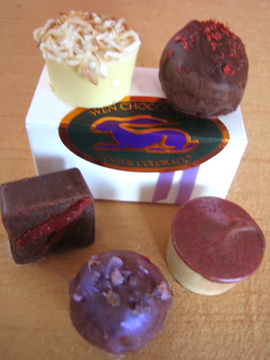
Clockwise from top left: Triglav, Mocja, Cairo,
Violette, Savannah.
|
Read about some of our other
favorites in these sections of
THE NIBBLE:
|
|
Enjoy Chocolate In These Forms
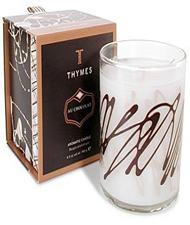 |
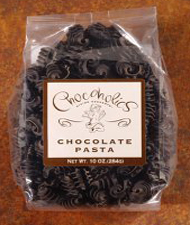 |
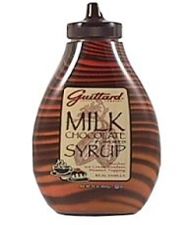 |
| Thymes Chocolate Candle. Coffee bean and cocoa bean unite in this fragrant blend of milk chocolate, espresso and vanilla. A truly great candle with an aroma that satisfies your chocolate cravings without any calories. This 6.5 ounce candle burns up to 50 hours. For our review of Thymes candles, click here. |
Chocoholics Chocolate Pasta. Made with enriched semolina, cocoa, and sugar, this chocolate pasta will make a grand finale dessert. Just cook like regular pasta and serve hot or cold with whipped cream or crème
anglaise and strawberries or raspberries. Click here for more information. To read our article on fabulous dessert pastas, click here. |
Guittard Milk Chocolate Syrup. If you make chocolate milk, make it with the best. You also can make a rich, hot cocoa without any powdery mess; drizzle the syrup over ice cream sundaes and baked goods for a quick-fix dessert; and add a squirt to espresso and mocha drinks for a bit of chocolate indulgence. Click here for more information. |
FOR ADDITIONAL INFORMATION, special offers,
contests, opinion surveys, THE NIBBLE
back issues archive, product gift-finder, links to our favorite
food websites, and the ability to nominate YOUR favorite nibbles,
visit the home page of TheNibble.com.
Do you have friends who would enjoy THE NIBBLE?
Click here to send them an invitation to sign up for their own copy. |
ABOUT THE NIBBLE. THE NIBBLE, Great Food Finds, is an online magazine plus newsletters about specialty foods and the gourmet life. It is the only consumer publication and website that focuses on reviewing the best specialty foods and beverages, in every category. The magazine also covers tabletop items, gourmet housewares, and other areas of interest to people who love fine food.
© Copyright 2004-2025 Lifestyle Direct, Inc. All rights
reserved. All information contained herein is subject to change at any time
without notice. All details must be directly confirmed with manufacturers, service
establishments and other third parties. The material in this newsletter may not
be reproduced, distributed, transmitted, cached, or otherwise used, except with
the prior written permission of Lifestyle Direct, Inc.
|
 |
|
 |









 writer, rose to the head-turning challenge. She sent us Wen Chocolates, new to our acquaintance. For such great chocolate, it arrived in unprepossessing boxes. But the first thing we learned as a young consumer—and in fact, the reason we began writing THE NIBBLE™ newsletter several years ago—is that packaging has nothing to do with the quality of what’s inside. Personally, when we buy chocolate for ourselves or as gifts for fellow food-lovers, we’re not buying pretty boxes and bows.
writer, rose to the head-turning challenge. She sent us Wen Chocolates, new to our acquaintance. For such great chocolate, it arrived in unprepossessing boxes. But the first thing we learned as a young consumer—and in fact, the reason we began writing THE NIBBLE™ newsletter several years ago—is that packaging has nothing to do with the quality of what’s inside. Personally, when we buy chocolate for ourselves or as gifts for fellow food-lovers, we’re not buying pretty boxes and bows. 
 Couverture is tempered to form a thin, smooth, shiny coating on hand-dipped candies. The extra cocoa butter, generally 36% to 39%, makes it easier to work with, allows for a thinner shell coating and gives it a different texture and consistency than non-couverture chocolate, i.e. chocolate bars. (Bars for eating can be 25% to 33% cocoa butter, depending on the quality of the bar.)
Couverture is tempered to form a thin, smooth, shiny coating on hand-dipped candies. The extra cocoa butter, generally 36% to 39%, makes it easier to work with, allows for a thinner shell coating and gives it a different texture and consistency than non-couverture chocolate, i.e. chocolate bars. (Bars for eating can be 25% to 33% cocoa butter, depending on the quality of the bar.) 


